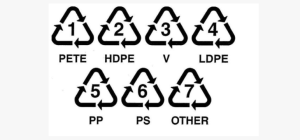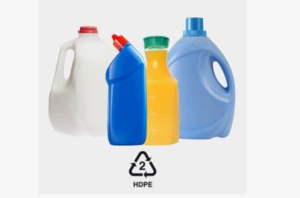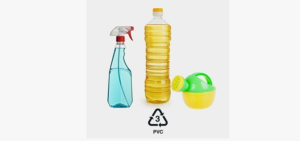
what kind plastic can be recycled?
In daily life, many people like to recycle used mineral water bottles or fruit juice bottles to hold water, oil, vinegar, soy sauce, pepper, etc. Some street vendors also use this method. Reusing plastic products is considered convenient and economical, and some people even think it is more environmentally friendly. However, they do not know that this bad habit can actually become a breeding ground for bacteria.
Careful friends may notice that at the bottom of every plastic container or bottle there is a recycling symbol with a triangle painted on the outside and a number inside. Its numbers range from 1 to 7, drawn within a recycled triangle. The mark was developed by relevant organizations in the U.S. plastics industry. The material identification code is placed on the container or packaging. Each material has different properties and uses. The editor here also reminds everyone of a very common misunderstanding. The triangle mark on the bottom of the bottle means recyclable. This “recyclable” does not mean that the bottle can be used repeatedly, but that the material can be recycled. For us consumers, this small triangle with a number in the center is like an ID card of the plastic component. We can get the specific component information of the material from the recycling logo to ensure that we use the correct material for the right application. purpose, so as to ensure our health and safety and avoid unnecessary harm.
·Plastic #1 is usually transparent and used to make mineral water and beverage bottles. Some think it is safe, but in fact, this plastic can cause bacterial buildup after prolonged use.
·This category mainly appears in soda bottles, water bottles, beer bottles, salad dressings, mouthwash bottles and peanut butter containers.
PET plastic has a porous structure that can absorb harmful substances such as bacteria over time, and becomes more pores after each use. Bacteria can exist inside the pores of the plastic, so you simply cannot clean it thoroughly.
Place such plastic beverage bottles in the dishwasher or other hot places, such as in a car in the summer, under direct sunlight, etc. As the temperature of this material increases, the plastic itself becomes easy to decompose, melt and release harmful chemicals like DEHP. Please try to avoid using it under such conditions. In addition, the beverage bottle cannot be used to hold solvents such as wine and oil.、
 d accepted by most recycling systems. This plastic is one of the 3 safe plastics and has a low risk of leaching. PE is the most widely used plastic in industry and life. It is generally divided into two types: high-density polyethylene (HDPE) and low-density polyethylene (LDPE). #2 here is LDPE, #4 below is LDPE. HDPE has a higher melting point and greater hardness than LDPE, and is more resistant to corrosive liquids.
d accepted by most recycling systems. This plastic is one of the 3 safe plastics and has a low risk of leaching. PE is the most widely used plastic in industry and life. It is generally divided into two types: high-density polyethylene (HDPE) and low-density polyethylene (LDPE). #2 here is LDPE, #4 below is LDPE. HDPE has a higher melting point and greater hardness than LDPE, and is more resistant to corrosive liquids.
·HDPE plastic is mainly used to make milk jugs, household detergent containers, juice bottles, shampoo bottles, detergent bottles, etc.
·Plastic containers that hold cleaning products and bath products can be reused after careful cleaning. However, these containers are usually difficult to clean. They retain the original cleaning products and become a breeding ground for bacteria. The cleaning is not thorough, so it is best not to recycle them.
·Plastic #2 type materials can be recycled to make pens, recycling containers, picnic tables, lumber, benches, fences, detergent bottles and more.
Editor’s suggestion: For #2 plastics, plastic containers for cleaning supplies and bath products can be reused after careful cleaning. However, these containers are usually difficult to clean, leaving the original cleaning supplies behind and becoming a breeding ground for bacteria. Cleaning It’s not thorough, so it’s best not to recycle it.

Due to its excellent processing, plasticity, and low price, it is widely used in non-food applications, such as manufacturing shampoo bottles, clean food packaging, edible oil bottles, medical equipment, raincoats, school bags, building materials, etc. Plastic film, plastic box, etc. These plastics may contain phthalates, substances that have been linked to a host of health problems, from developmental problems to miscarriage. They also contain DEHA, which poses a cancer risk with long-term exposure. DEHA has also been linked to bone mass and liver problems. Try not to burn this material or cook with it.
·Plastic #3 contains chemicals such as chlorine, lead, DEHA and harmful dioxins. These can lead to various health risks, such as birth defects, hormone disorders, and cancer. Coupled with the rising awareness of environmental protection in recent years, industry players have gradually switched to using other materials for filling containers with products.
·Most of this material can only be used below 81 degrees. Substances harmful to the human body are released under high temperature conditions. Generally, this kind of plastic is rarely used in food packaging, and its residues are difficult to remove.
Post time: 05-30-2024



